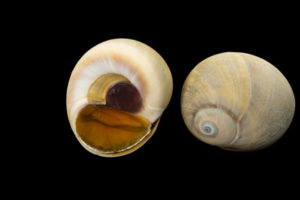
As we enter their world to explore, care and respect should be shown by being aware of where we walk, leaving specimens where you find them, explaining to others the wonder of the marine life that surrounds the island where we live.ĪLWAYS CHECK THE TIDE CHARTS BEFORE VENTURING OUT ON TO THE SAND BARS AT LOW TIDE. Usually covered by 50 m of ocean the kelp, eel grass, clams, star fish, moon snails and many other miniscule inhabitants patiently wait for the inevitable, the tide to return. The beauty of the ocean floor is often unseen by many people. It is a wonderful time to explore the magical mystical intertidal zones around Gabriola. June is often a time of extreme low tides. Many are seen at low tide and are sometimes destroyed by people not knowing these are living organisms.

The egg collar has the look of something human made.
Moon snail free#
In mid summer the larvae hatch and swim around in the egg collar until it disintegrates and then they swim free in the ocean.

The sand is cemented together by a sticky mucous the snail produces which then hardens and forms a rubberized sand collar. The eggs are pressed together with particles of sand to form a distinctive sand collar ring around the snail’s shell. Moon snails lay thousands of tiny eggs during spring and summer. Clamshells can be found with a perfect hole in their shell near the hinge you can bet they were lunch for the moon snail. This has a softening effect on the mollusks shell and aids the moon snail in drilling through the shell. The moon snail is equipped with enzyme secretions of carbonic andydrase. When it encounters clams it uses its large foot to grasp the clam and then it bores into the clam with its radula a long ribbon like tongue, which contains thousands of teeth. The moon snail is often not seen because it burrows beneath the sand looking for its food. The moon snail is also cannibalistic and sometimes feeds on its own species !! The Sunflower Star with its many rays is a feared predator of the moon snail. However the snail does not stay in its sealed shell for long, as it cannot breathe so the whole process is now reversed. The opening of the shell is then sealed with a tight fitting door or operculum. This enormous foot, which almost completely envelops the shell, is actually water filled and if the moon snail is disturbed it can quickly expunge the water from its foot and withdraw into its shell. What is most unique about this snail is it has a huge fleshy foot, which extends out of its shell and acts like a snow plough as it ploughs through the sand looking for clams, mussels or other mollusks.

(Think about the size of a large fist) The shell can be a pinkish, cream, beige or a deep yellowish brown. This fascinating snail boasts a distinctive globe like shell made up almost entirely of one great whorl about 130mm in diameter topped with 5 or 6 smaller whorls spiraling to a point. (Studies claim the moon snail was discovered by Merriwether Lewis of the Lewis & Clarke Expedition when they reached the mouth of the Columbia River. It is the one of the largest snails found on our coast and its range extends down the Pacific coast to Baja Mexico. The Lewis’ Moon Snail euspira lewisii is a predator that inhabits soft silty sand or mud flats in protected bays and intertidal areas and lives at a depth of about 50m. When the tide goes out another world is exposed to us, with some beautiful and unusual plants and animals. Gabriola is an island surrounded by a vibrant, powerful ocean.


 0 kommentar(er)
0 kommentar(er)
